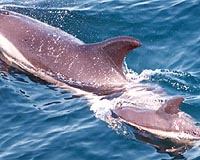| . |  |
. |
Hong Kong (AFP) May 25, 2009 A group of conservationists and scientists is due to set sail for an obscure corner of the Pacific Ocean in the coming months to explore a vast swirl of waste known as the "Plastic Vortex." The giant gloop -- which some scientists estimate is twice the size of Texas -- has been gradually building over the last 60 years as Asia and the United States tossed their unwanted goods into the ocean. Everything from flip-flops to plastic bags have been slowly broken down by the sun's rays into small particles, and ocean tides have meant much of it has settled in a spiralling pattern just below the ocean surface between Hawaii and the mainland United States. After only coming to scientific attention in recent years, little remains known about the vortex, also known as the "Eastern Garbage Patch," so the expedition hopes to find out if the plastic can be fished out of the sea -- and what can be done with it. Jim Dufour, a senior engineer at Scripps Institution of Oceanography in California, who is advising the trip, said establishing the extent of the problem was vital for the future health of the oceans. "Importance is an understatement, it's imperative. It will take many years to understand and fix the problem," he told AFP. The United Nations Environment Programme says around 13,000 pieces of plastic litter are found in every square kilometre of sea, but the problem is worst in five ocean gyres, or spiralling ocean currents, the worst of which is in the North Pacific. The plastic has become so small most of it cannot be seen by satellite pictures, but the volume means the poisonous soup is being unknowingly vacuumed up by marine life and birds, and much of it is heavy with toxic chemicals, organisers of the trip say. "That means the little piece of plastic the fish eats is actually a little toxic bomb," said Doug Woodring, an entrepreneur and conservationist who lives in Hong Kong and will lead the expedition. As a result, a lot of the toxins could be getting into the human food chain. Woodring said the location of the swirl -- more than 500 nautical miles from the west coast of the United States -- meant it remains a mystery for scientists. "It is like going to outer space," he told AFP. The 50-day voyage will head from San Francisco to Hawaii and back, passing through the vortex twice. It will be led by a 150-foot-tall (45-metre-tall) ship, the "Kaisei" -- which means Ocean Planet in Japanese. Accompanying will be a fishing trawler, which will be trying out techniques to catch the waste without destroying too much marine life. "You have to have netting that is small enough to catch a lot but big enough to let plankton go through it," said Woodring. Ocean scientists and a documentary crew will be on the trip, which also hopes to examine whether the waste can be recycled or even used to create fuel. The mission -- which is still looking for funding to meet its two million US dollar budget -- has received the backing of the United Nations Environment Programme and sponsorship from water company Brita. But the swirl's location in international waters meant it was difficult to get any government support to clean it up. "There is no jurisdiction, no government who is entirely responsible, so there has been no push to clean it up. The world doesn't know it is out there," said Woodring. Several other trips have either made or planned journeys to the vortex, but Dufour says this will be the most scientific-focused venture. "It will be the first scientific endeavour studying sea surface pollutants, impact to organisms at intermediate depths, bottom sediments, and the impacts to organisms caused by the leaching of chemical constituents in discarded plastic," he said. But for everyone involved in the project, the phenomenon only highlights the wider issue of reducing waste. "The real fix is back on land. We need to provide the means, globally, to care for our disposable waste," said Dufour.
Share This Article With Planet Earth
Related Links Our Polluted World and Cleaning It Up
 Contaminants In Marine Mammals' Brains
Contaminants In Marine Mammals' BrainsWoods Hole MA (SPX) May 22, 2009 The most extensive study of pollutants in marine mammals' brains reveals that these animals are exposed to a hazardous cocktail of pesticides such as DDTs and PCBs, as well as emerging contaminants such as brominated flame retardants. Eric Montie, the lead author on the study currently in press and published online in Environmental Pollution, performed the research as a student in the Wood ... read more |
|
| The content herein, unless otherwise known to be public domain, are Copyright 1995-2009 - SpaceDaily. AFP and UPI Wire Stories are copyright Agence France-Presse and United Press International. ESA Portal Reports are copyright European Space Agency. All NASA sourced material is public domain. Additional copyrights may apply in whole or part to other bona fide parties. Advertising does not imply endorsement,agreement or approval of any opinions, statements or information provided by SpaceDaily on any Web page published or hosted by SpaceDaily. Privacy Statement |